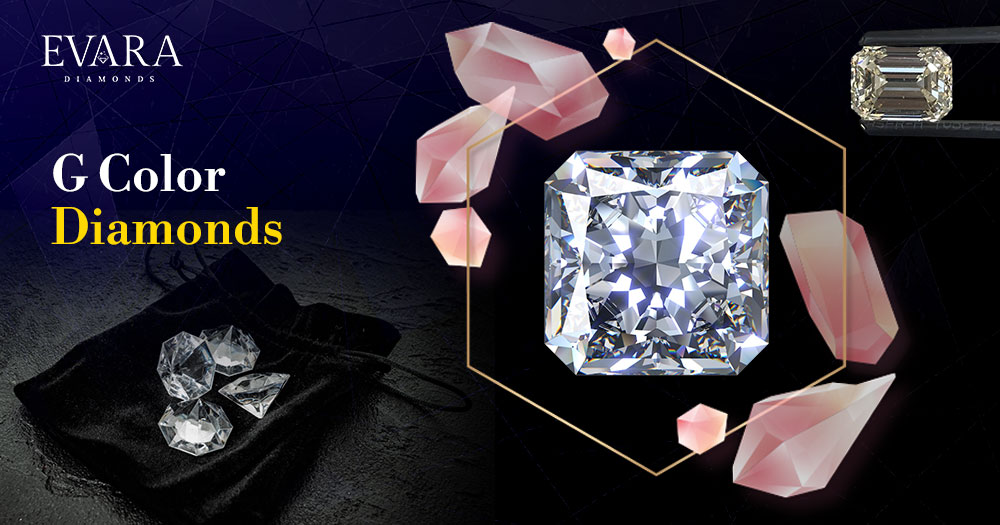G Color Diamonds- A Complete Guide

Is it Worth Buying G-Color Diamonds?
If you’re wondering whether G-color diamonds are a smart investment, you’re not alone. Many buyers grapple with the same question when choosing the right gemstone.
When it comes to a diamond’s color, cut, and clarity, even slight variations can significantly impact its price and value. That’s why it’s crucial to consider all aspects before selecting the perfect stone.
To simplify diamond grading, the Gemological Institute of America (GIA) introduced a color scale in the 1950s, ranking diamonds from D (completely colorless) to Z (stones with noticeable tint).
G-color diamonds fall under the “near colorless” category, alongside H, I, and J grades. Under normal lighting, these stones appear icy white, much like higher-grade diamonds, but with a faint hint of warmth that is nearly imperceptible without specialized tools.
If you’re considering a purchase, this guide will help you understand how G-color diamonds compare to other options and why they might be the right fit for you.
What Are G-Color Diamonds?
The GIA classifies diamonds into five categories:
- D-F: Colorless
- G-J: Near colorless
- K-M: Faint color
- N-R: Very light color
- S-Z: Noticeable color
G-color diamonds fall in the “near colorless” range, meaning they contain minimal traces of warmth that are difficult to detect without magnification. When cut with precision, these gems appear virtually identical to higher-grade diamonds under normal lighting conditions.
The main advantage of choosing a G-grade diamond is that it offers the same brilliant, icy appearance as its pricier counterparts but at a more affordable price.
G-Color vs. Other Grades
Buyers often worry that a G-grade stone will appear yellowish compared to D-F diamonds. However, this concern is largely unfounded. Under typical lighting, a well-cut G-diamond exhibits the same luminous brilliance as a D-grade stone, making the visual difference negligible.
The key factor is the cut. A round brilliant cut, in particular, enhances the stone’s ability to reflect light, making any minor tint even less noticeable. This is why G-grade diamonds offer a great balance between quality and value.
When compared to H-J diamonds, G-color stones stand out due to their superior whiteness. Lower-grade diamonds tend to show more noticeable warmth, which becomes more pronounced as carat size increases. By contrast, a well-cut G-diamond maintains its crisp brilliance without a visible tint.
How Expensive Are G-Color Diamonds?
Opting for a G-grade diamond can be a cost-effective choice. Compared to D-F diamonds, these stones are significantly more affordable—often saving buyers 10-25%—without sacrificing visual appeal.
Beyond color, factors like cut, clarity, and carat weight influence a diamond’s price. A well-cut G-color diamond with excellent clarity can still offer exceptional sparkle at a lower cost than a higher-grade stone.
When is a G-Color Diamond the Best Choice?
A G-color diamond is ideal in several scenarios:
- Engagement rings with halo settings: The center stone will blend seamlessly with surrounding diamonds, maintaining an elegant, colorless appearance.
- Yellow or rose gold jewelry: The slight warmth of a G-grade stone complements these metals beautifully, enhancing the overall look.
- Budget-conscious buyers: If you want a high-quality diamond without overspending, G-color offers a fantastic balance of beauty and affordability.
When to Consider a Different Grade
While G-color diamonds provide excellent value, there are situations where another grade might be preferable:
- For those with a higher budget: If cost isn’t a concern, D-F diamonds offer absolute colorless perfection.
- Platinum or white gold settings: For these metals, a D-F diamond may be a better match, as even the faintest warmth can be more noticeable.
- Alternative cuts: Fancy cuts like emerald or Asscher shapes tend to highlight color more, making a higher grade preferable if you’re seeking an ultra-clear appearance.
Conclusion
For most buyers, it’s nearly impossible to distinguish a G-color diamond from a D or E without magnification. These near-colorless stones provide a fantastic compromise between price and quality, particularly in round brilliant cuts. If you’re looking for a stunning diamond that offers both value and brilliance, a G-grade stone could be the perfect choice.
FAQ
1. Is G Color Good for a Diamond?
Yes, G-color is good for a diamond, it represents the “nearly colorless” grade, and diamonds in this category exhibit the same brilliance as diamonds with higher color grades like D, E, or F. With the naked eye, it is very difficult to establish any difference between the two and it costs less than higher color-grade diamonds.
2. Is G VS1 a Good Diamond?
GVS1 is a good diamond, as it offers nearly colorless sparkle with undetectable yellow tints under normal lighting conditions. It helps buyers maintain the right balance between quality and price, without compromising on overall appearance.
3. What is the Difference Between G VS1 and G VS2?
The exhibition of clarity is the main basis of the difference between the GVS1 and GVS2 diamonds. A GVS1 diamond showcases minimal tints under specific conditions and magnification in comparison to a GVS2 diamond. However, both diamonds display colorless brilliance and clarity when seen with the naked eye under normal conditions.